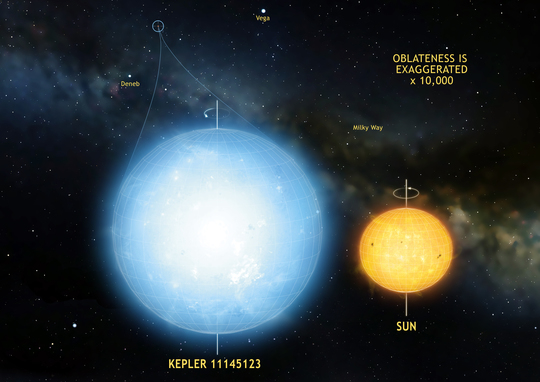Astronomy - Astronomers Discover Roundest Star
Asteroseismologists delving into the Kepler mission's data trove have found a star that appears to be more spherical than any natural object.
News flash! This just in: a star is round!
OK, on the face of it this result, published in the November 16 Science Advances, seems worthy of sarcasm. But actually, it is a surprise that a star should be spherical.

The star KIC 11145123 is the roundest natural object ever measured in the universe. Stellar oscillations imply a difference in radius between the equator and the poles of only 3 kilometers (2 miles). This star is significantly rounder than our squat Sun.
Mark A. Garlick
Mark A. Garlick
As a rule, stars, planets, and other celestial objects spin, and as they whirl they bulge out along their equators, meaning they’re shaped more like squat onions than perfect spheres. Rotational forces create equatorial bulges on the Sun, the Moon, and Earth, too: our planet’s equatorial radius spans 43 kilometers (27 miles) more than its polar radius, a difference of 0.3%.
A star’s waistline reveals more than just its spin: stellar winds, attendant planets or companion stars, and magnetic fields can also affect how squat a star becomes. So astronomers were intrigued to now find a star that’s round to within 0.0002% — a shape so uniform, the authors called it “the most spherical natural object ever measured.”
More Than Points of Light
For most astronomers, ancient or modern, stars are little more than points of light. Truly seeing a star and resolving its shape is a Herculean feat — stars may be enormous, but they’re also incredibly far away.
Nevertheless, it’s been done: astronomers using infrared interferometry managed to directly image the shapes of Altair and Vega, both rapidly rotating stars. (Altair has a significant bulge of 14%, while Vega turned out to be spinning with its pole pointed at Earth, making its oblateness too difficult to measure.)
Laurent Gizon (Max Planck Institute for Solar System Research and Georg-August University, both in Göttingen, Germany; National Astronomical Observatory of Japan, Tokyo; and New York University Abu Dhabi, United Arab Emirates) and colleagues tried a different tack on a star with the call sign KIC 11145123 in the primary Kepler mission’s field of view.
“This is in many regards a very surprising star,” says Jorgen Christensen-Dalsgaard (Aarhus University, Denmark), who was not involved in the study. As an A-class star, it’s more than twice as wide as the Sun. But unlike fellow A stars Altair and Vega, it spins slowly, completing a rotation every 100 days, compared to the Sun’s roughly 26-day equatorial period. The slow rotation may be a sign of its age.
Rather than image this star directly, Gizon’s team followed its variations in brightness over four years, watching the star expand and contract ever so slightly as sound waves rang through its interior. The study of those celestial sounds is known as asteroseismology. That field really took off when Kepler began monitoring thousands of ordinary stars with exquisite precision over the four years of the spacecraft’s primary mission.

This illustration shows acoustic modes propagating in a star after reflection off the surface. Gravity modes are shown propagating internally.
IAC
IAC
Gizon’s team was able to measure KIC 11145123’s shape by modeling sound waves as they bounced off the star’s surface and back into its interior. If you pluck a guitar string, only a certain number of waves can vibrate along the string depending on its length; similarly, only certain frequencies can vibrate within a star depending on its shape. By measuring the frequencies of different modes, the astronomers could determine the star’s radius at different latitudes.
The result, an equator that bulges only 0.0002% more than the poles, is only one-third as squat as astronomers expected, given the star’s rotation. The authors suggest that a weak magnetic field may surround the star’s equator like a girdle, keeping the star in trim spherical shape.
Christensen-Dalsgaard agrees that a magnetic field may be at work in this peculiar star, “but this is clearly something that will require, and motivate, more work.”
Really the Roundest?
So that brings us back to the critical question that may someday save you on Trivial Pursuit: is KIC 11145123 really the roundest celestial object we’ve ever measured?
If we’re counting solid objects, than we shouldn’t forgetMercury and Venus, both of which are spherical to within one-tenth of a kilometer due to their slow rotations. Unfortunately, NASA’s measurements are one significant figure short of the precision needed to call the contest. The planets’ place at the round table will have to await future planetary missions.
If we limit the comparison to other stars, then the answer — for now, at least — becomes more straightforward: yes, this is the roundest star known. Don’t expect it to stay that way though. The Kepler data have been combed pretty thoroughly for transiting exoplanets, but thousands of transitless stars are a treasure trove waiting for curious asteroseismologists.
“Since we do not fully understand this star it is hard to predict whether it is almost unique or whether other examples could be found in the galaxy,” Christensen-Dalsgaard. “There is certainly potential for further discoveries of a similar nature as we continue the work on these remarkable data.”
This is an advertisement:
https://linksredirect.com/?pub_id=11719CL10653&source=linkkit&url=https%3A//paytm.com/shop
This is an advertisement:
https://linksredirect.com/?pub_id=11719CL10653&source=linkkit&url=https%3A//paytm.com/shop

No comments:
Post a Comment